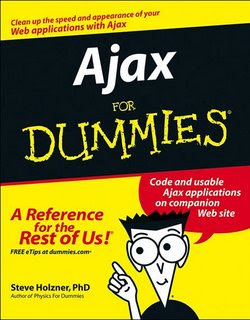Making Web applications look and feel like desktop applications is what ffl this book is all about — that’s what Ajax does. Although Web development is getting more and more popular, users still experience the nasty part of having to click a button, wait until a new page loads, click another button, wait until a new page loads, and so on.
That’s where Ajax comes in. With Ajax, you communicate with the server behind the scenes, grab the data you want and display it instantly in a Web page — no page refreshes needed, no flickering in the browser, no waiting. That’s a big deal, because at last it lets Web applications start to look like desktop applications. With today’s faster connections, grabbing data from the server is usually a snap, so Web software can have the same look and feel of software on the user’s desktop.
And that, in a nutshell, is going to be the future of Web programming — now the applications in your browser can look and work just like the applications installed on your computer. No wonder Ajax is the hottest topic to come along in years.
This book gives you the whole Ajax story, from soup to nuts. It starts with a tour of how Ajax is used today, taking a look at some cutting-edge applications (as well as some games). Then, because Ajax is based on using JavaScript in the browser, there’s a chapter on how to use JavaScript (if you already know JavaScript, feel free to skip that material).
Then the book plunges into Ajax itself, creating Ajax applications from scratch, from the beginning level to the most advanced. And you’ll see how to put many of the free Ajax frameworks, which do the programming for you, to work. Because Ajax also often involves using XML, Cascading Style Sheets (CSS), and server-side programming (using PHP in this book), there’s also a chapter on each of these topics.
You can also leaf through this book as you like, rather than having to read it from beginning to end. Like other For Dummies books, this one has been designed to let you skip around as much as possible. You don’t have to read the chapters in order if you don’t want to. This is your book, and Ajax is your oyster.
That’s where Ajax comes in. With Ajax, you communicate with the server behind the scenes, grab the data you want and display it instantly in a Web page — no page refreshes needed, no flickering in the browser, no waiting. That’s a big deal, because at last it lets Web applications start to look like desktop applications. With today’s faster connections, grabbing data from the server is usually a snap, so Web software can have the same look and feel of software on the user’s desktop.
And that, in a nutshell, is going to be the future of Web programming — now the applications in your browser can look and work just like the applications installed on your computer. No wonder Ajax is the hottest topic to come along in years.
This book gives you the whole Ajax story, from soup to nuts. It starts with a tour of how Ajax is used today, taking a look at some cutting-edge applications (as well as some games). Then, because Ajax is based on using JavaScript in the browser, there’s a chapter on how to use JavaScript (if you already know JavaScript, feel free to skip that material).
Then the book plunges into Ajax itself, creating Ajax applications from scratch, from the beginning level to the most advanced. And you’ll see how to put many of the free Ajax frameworks, which do the programming for you, to work. Because Ajax also often involves using XML, Cascading Style Sheets (CSS), and server-side programming (using PHP in this book), there’s also a chapter on each of these topics.
You can also leaf through this book as you like, rather than having to read it from beginning to end. Like other For Dummies books, this one has been designed to let you skip around as much as possible. You don’t have to read the chapters in order if you don’t want to. This is your book, and Ajax is your oyster.
Download









 /blockquote>a>
/blockquote>a>
0 komentar:
Posting Komentar